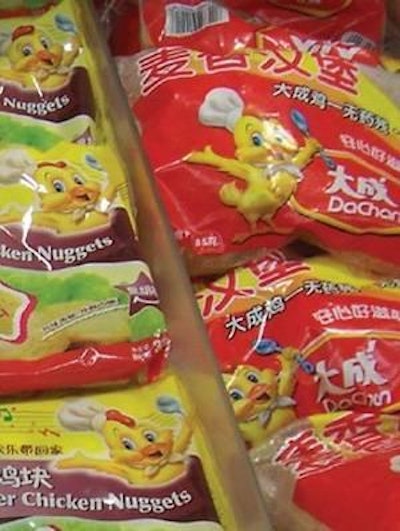
China's chicken exports are expected to bounce back this year with growth reaching double digits. The turnaround follows the declines recorded in early 2008, and is the result, experts say, of improvements in quality controls and the removal of the European Union's ban on cooked chicken.
China's Ministry of Commerce has revealed that exported chicken meat and related products fell by 25% during the first half of 2008, to 177,007 metric tons. Exports by value have decreased by 17% over the same period to stand at $510 million.
However, 2009 is expected to be different. Xie Gang, agricultural analyst with Shanghai's Sinolink Securities Co Ltd, predicts: "The growth rate of total Chinese chicken exports by weight will increase by 10-20%."
Xie is not alone. His views are echoed by Guo Huiyong, agricultural analyst at Beijing Orient Agribusiness Consultant Ltd, who believes that exports by weight will grow by 10-15% this year. Producers, however, expect the increase to be even higher, growing by as much as 30%.
Applying standards
A key driver for export growth is higher quality standards. A series of contamination reports, including melamine contamination of feed and eggs, has focused attention on China's quality standards. Both the private and public sector have responded by applying controls more firmly.
As well as an increased focus in Beijing, local, on-the-ground monitoring has also been stepped up.
Zhu Facheny, deputy chief of the General Department of the Ministry of Husbandry of Shandong Province, says that the Shandong government, for example, established the position of official veterinarian back in 2002. Today, there are 1,380 official veterinarians working in the province, inspecting exporting poultry farms, the quality of feed, production conditions and processing standards.
"We will not allow any companies to export their products unless we are 100% sure of the quality of the exported meat," Zhu explains.
The EU's lifting of its ban on China's cooked chicken will not only boost China's exports to the region but will also help to improve the competitive position of Chinese producers in other parts of the world.
The EU first banned Chinese chicken meat back in August 2006, due to concerns over disease and drug residues. The region had been a major customer for China, which had exported over 20,000 metric tons to the EU annually. The ban was extended to all food of animal origin in 2002, following the discovery of contamination in imported shrimp.
The ban was lifted in September 2008. On November 27, 60 metric tons of exported cooked chicken meat left for the EU.
"I expect Shangdong province will export about 100,000 metric tons of cooked poultry meat to the European Union in 2009," says Wang Yongsheng, spokesman for Shandong-based Zhucheng Waimao Co Ltd.
The income achieved from selling to Europe will be used by Zhucheng Waimao to lower its prices in Asian markets. The company hopes to be able to compete against Thai producers for the Japanese market.
In total, the EU has approved poultry meat exports from nine Chinese companies. Zhucheng, one of the approved companies, has signed a contract valued at $2.4 million with a Dutch importer and successfully exported 60 metric tons of cooked chicken at the end of last year.
"Zhucheng can easily export about 10,000 metric tons of prepared chicken meat to the European Union. We expect to reach 15,000 metric tons this year," said Wang. He also noted that the other approved exporters also expect to ship similar amounts.
Cooked chicken meat is an area of particular strength for China, as it requires more labour an area in which the country has a significant cost advantage.
The profit margin for exported cooked chicken is up to 15% while that of frozen uncooked chicken is only 10%.
Shang Jiguo, dean at the International Economic and Trade Department of Shangdong Agriculture University, explains: "Owing to lower labour costs, Chinese companies produce high-value cooked chicken meat at comparatively low expense."
Lingering concerns
But China's problems have not disappeared. In January, local health authorities announced that an 18-year-old woman in Beijing had contracted avian influenza. If the disease spreads, or if other safety issues surface, exports may be restricted or even halted, especially live chicken exports to Hong Kong and Macau.
"This case will affect exports until the source is properly identified and the spread is contained and eliminated," says Marcos Sanchez, assistant professor at the Department of Poultry Science at Texas A&M University.
He continued that the areas hardest hit would be around Beijing, where the case was first identified.
However, other provinces may also be affected. Customers in Hong Kong and Macau prefer to buy their chickens live and if avian influenza is found in the south of the country the impact on this trade will be significant.
While avian influenza may have had a major effect on China's chicken exports in the past, local predictions are that the government is now able to better control the disease, meaning that, should further outbreaks occur, their impact is expected to be less seriously felt.
















